We’ve all heard of organ transplants, but many people don’t know that parts of the eye can be transplanted too, namely the cornea.
The cornea
The cornea is the clear, outer layer of the eye and is composed of three components: the outermost layer or epithelial layer, the middle or stromal layer, and the inner or endothelial layer.
The innermost layer is composed of a single layer of thousands of small pump cells that are responsible for pumping fluid out of the cornea so it can remain clear and provide good vision for the eye. If these pump cells become damaged or dysfunctional in any way, the cornea fills with fluid and becomes swollen and cloudy, resulting in blurry vision.
There are many ways endothelial cells can be lost, including aging, inherited disease (most commonly Fuchs’ corneal dystrophy), trauma or from a previous eye surgery. If a critical amount of these cells are lost, a corneal transplant operation is needed.
Cornea transplants
Until around the year 2000, corneal transplants consisted of a “full thickness” procedure where all three layers were replaced with donor tissue. Recently, improvements have been made and through research, an improved technique has been utilized with great success. Descemet’s Membrane Endothelial Keratoplasty, or DMEK, has largely replaced full thickness procedures in that it only replaces the endothelial cell layer.
In DMEK, a thin button of donor tissue containing only endothelial cells is placed on the back side of a weakened cornea through an incision. Once the layer of cells is placed, a small air bubble is introduced underneath the cell layer to hold it in place against the stromal layer of corneal cells. Following surgery the patient will need to lay down and look up toward the ceiling for the bubble to gently press the new layer of cells in place. This will need to continue for several hours on the day of surgery. In time, patients will have several follow up appointments and use several eye drops which are culled down to usually only one six months after surgery.
There are several advantages to DMEK when compared to the full thickness procedure. The DMEK procedure is considerably shorter in duration and the wound is smaller, which allows for quicker healing times. Most patients have the majority of their vision back within 3 or 4 months and will often require a new glasses prescription. In the long term, vision continues to improve for up to 3 years following surgery.
Tower Clock Eye Center’s Dr. Matthew Thompson, MD, is a fellowship trained cornea specialist who has a vast experience in cornea transplants. If you have vision issues and are curious about learning more about your eye health, call us at 920 499-3102 to set up an appointment.
Tagged with: cornea, cornea specialist, Dr. Matthew Thompson, Eye disease, eye surgeon
Posted in: Blog, New Announcements








